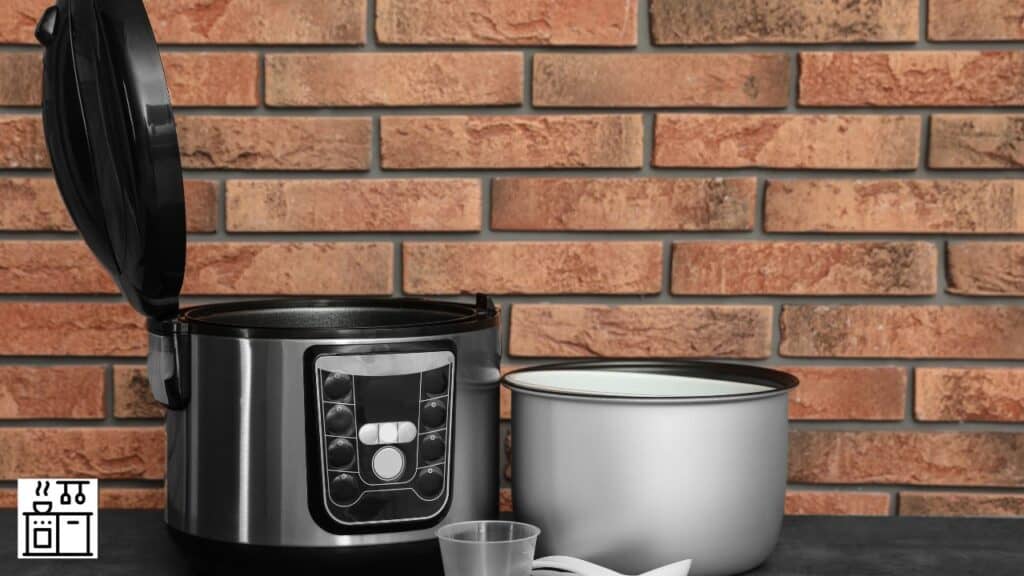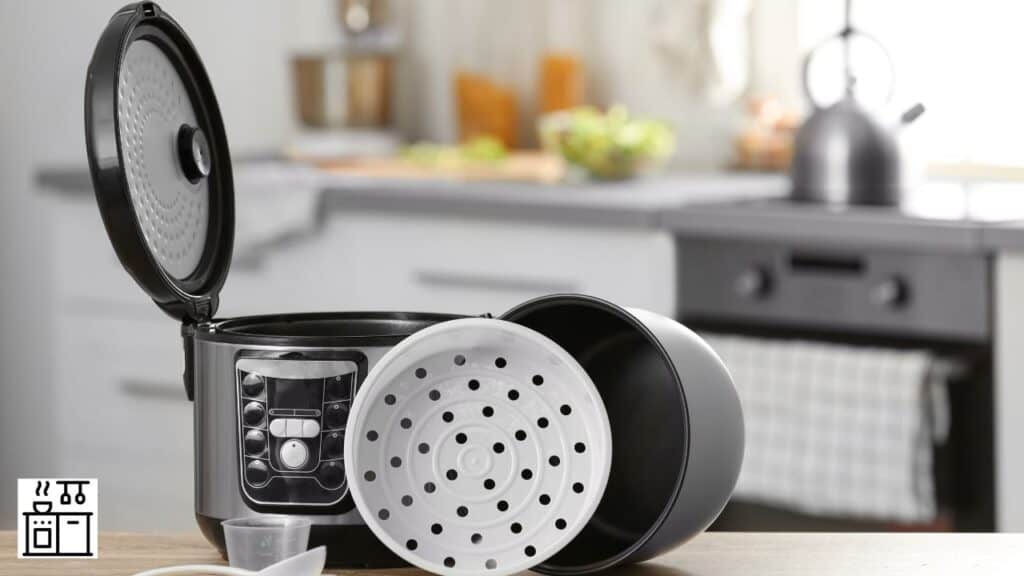Since the first electric rice cooker was introduced in 1955 by Toshiba, these kitchen appliances have been in great demand.
Though the primary function of a rice cooker is to cook rice, it can serve various other purposes too.
The exact capabilities will vary by model, with multi-functional rice cookers doing much more than basic models.
Let’s look at the different components of both complex and basic rice cooker models.
Common Parts of A Rice Cooker and Their Functions
Here is an overview of the most important parts of any rice cooker.
1. Power Cable
Rice cookers operate on electricity. So the power cable is an essential part of a rice cooker. It connects the appliance to the electrical source.
For the rice cooker to work, the power cable should be connected to an electric socket supplying power.
The power cable of a rice cooker may be integrated with the appliance, or it can be detachable.
2. Housing
The power cable is connected to the cooker housing. This part has a heating element at the base.
It basically houses all the parts of the rice cooker, including the display and toggle switches.
The cooker housing is typically made of heat-resistant plastic, polymer, or other insulating material.
3. Inner Cooking Pot
The inner pot holds the contents that are to be cooked. It’s made of metal and may have a non-stick coating.
The pot is placed inside the housing, on top of the heating element. Ingredients like rice and water are placed in the cooking pot.
When the pot heats, the water boils and cooks the contents.
The inner cooking pot has lines that indicate the water level. This makes it easy to accurately add enough water for cooking.
4. Lid
Every rice cooker has a lid. But the design of the lid varies from one model to another.
In some cases, the lid is attached to the cooker housing. These lids can only swing open or close.
However, simple rice cooker models may have a detachable lid that you can take off.
5. Base Unit
The base unit of the rice cooker is present inside the cooker housing. It carries the heating element that produces heat for the rice cooker to cook rice.
Depending on the model, the heating element may be concealed, making the base of the cooker appear flat.
Some rice cookers have the heating element concealed inside the base.
6. Control Panel
The control panel is in the front of the cooker. The structure and functions of the control panel of a rice cooker vary significantly across brands and models.
Simple rice cookers have a switch to toggle the cooking process. Slightly more advanced models will have a “Keep Warm” option also that can be engaged.
In more advanced rice cooker models, the control panel includes a display screen showing the temperature and mode of cooking.
The control panel may also have a button panel with different cooking options for white rice, brown rice, porridge, and many more.
Some of them may even have additional features like Sauté and Cake for preparing more elaborate recipes.
Additional Parts of A Rice Cooker

The above parts are common for all rice cookers, both basic and advanced models.
However, there are certain other parts that are present only on certain rice cookers.
They are not critical for the regular functioning of a rice cooker and hence may be absent in simple models.
Let’s look at what they are.
1. Steam Release
You may know that a rice cooker produces a lot of steam for cooking.
Too much steam will increase the pressure of the rice cooker, which is undesirable. So you will need an outlet for the steam.
A simple rice cooker has holes to expel steam during cooking.
Excess steam and moisture will gradually be released into the environment through these holes.
But other rice cookers will usually have a steam release unit attached to the lid.
2. Lid Lock or Float Valve
Simple rice cookers have detachable lids that you can easily open. However, other models have swinging lids with one end attached to the housing.
Such lids will carry a lid lock or floating valve to lock the lid in place.
Most of the time, the lid lock will directly engage when you press it down.
It will, however, have to be manually pushed to open the lid to check on the contents.
3. Lid Inserts
The lid insert is present in complex rice cooker models. It’s located just below the lid of certain rice cookers.
It’s a detachable part that prevents steam and food from reaching the actual lid.
This makes cleaning the rice cooker easier since you can remove and wash the lid insert.
4. Handles
Rice cookers will either have handles on either side or the top of the lid, depending on the model and brand.
This makes it possible to move the cooker from one place to another even when it’s hot.
The handles are always made of heat-resistant plastic or polymer.
5. Condensation Collector
Some rice cooker models have a condensation collector to trap excess moisture released by the rice cooker.
It’s usually located on the back of the rice cooker body and is detachable.
When it fills with water, you can remove it to get rid of the water. You can wash it and return it to its original place.
6. Spoon Holder
Some rice cookers have a small slot at the base of the housing to hold the stirring spoon.
This makes it easy to retrieve the spoon to stir the contents.
Internal Components of A Rice Cooker
The parts we previously saw are all easily accessible and visible in a rice cooker. Apart from these parts, there are also certain concealed components.
They are very important for the normal functioning of the rice cooker.
However, these parts are delicate and hence are concealed to keep them functioning for much longer.
Let’s find out what they are.
1. The Control Circuits
The control panel is linked to the control circuit, which contains all the electronics to operate the rice cooker.
Depending on the level of functionality, the circuit may be simple, or it may involve advanced electronic components like microprocessors for different control settings.
The control panel is thoroughly concealed to protect the components from the environment, moisture, and heat.
2. Thermostat
The rice cooker has a thermostat that automatically regulates temperature.
The purpose of this device is to help the rice cooker switch from Cooking to “Keep Warm” or Shut Down mode when the rice is ready.
To do this, it continuously assesses the temperature of the cooking pot.
When all the moisture has been absorbed by the rice or other contents inside the pot, the temperature of the pot starts rising.
The thermostat detects this significant change in temperature and switches the mode.
3. Thermal Fuse
The thermal fuse cuts the supply to the rice cooker to protect its internal circuitry in the event of a power surge or internal damage.
It’s a protective device that is located within the internal circuitry and the power plug.

